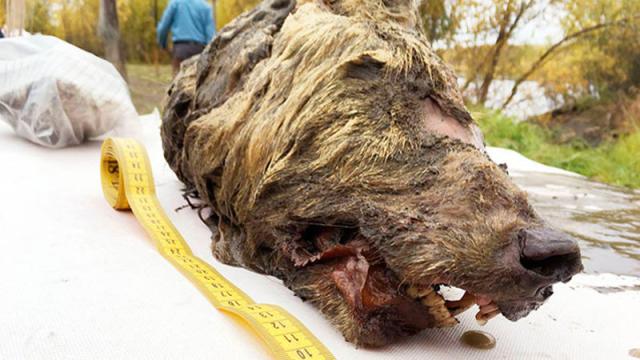A well-preserved head belonging to an ancient species of Pleistocene wolf has been pulled from the permafrost of northeastern Siberia. The enormous, well-preserved head could yield important genetic information about the evolutionary history of wolves and the origin of domesticated dogs.
A local resident living in the Abyisky district in northern Yakutia, Siberia discovered the disembodied head in melting permafrost during the summer of 2018, the Siberian Times reported. The discovery was made public at the Miraikan National Museum of Emerging Science and Innovation in Tokyo, Japan during the grand opening of its mammoth exhibit.
“This discovery is amazing,” Julie Meachen, a vertebrate paleontologist and an associate professor at Des Moines University, said in an email to Gizmodo. “It made me want to go to Siberia and look for more Ice Age specimens. It looks like it died yesterday! We’ve never seen an Ice Age wolf in the flesh before and this is a huge specimen.”
The fully grown Pleistocene wolf was around two to four years old when it perished. Images of the wolf taken by Albert Protopopov, a researcher at the Republic of Sakha Academy of Sciences, show clumps of thick fur on its head, an immaculate snout, and a terrifying set of fangs. The head is enormous, measuring 15.7 inches (40 cm) in length. A modern wolf’s head measures only 9.1 to 11 inches (23 to 28 cm).
Meachen, a specialist in the evolution and geographical spread of ancient wolves, said the the preserved brain will be especially interesting to study. The soft tissues, she said, could provide new insights into these creatures, since those are not usually preserved in the fossil record. The researchers might even be able to do some interesting work with the tissue inside the nasal passages “in terms of what was for sensory (smelling) purposes and what was for thermoregulatory (heating and cooling) purposes,” said Meachen, who’s not involved with the research.
As reported in the Siberian Times, Japanese scientists dated the head to at least 40,000 years ago, placing the fearsome carnivore to the late Pleistocene. Ancient wolves, including the iconic dire wolves, came in extra large sizes during this period, hunting large game, such as bison, camels, and horses. The end of the last Ice Age, between 20,000 to 10,000 years ago, coincided with the extinction of these bulky wolves, as climate change—and possibly competition with humans—contributed to the loss of their accustomed prey.
When asked if this might be a dire wolf, Meachen said it’s doubtful.
“Currently, our knowledge of [ancient wolves] suggests that above 55 degrees N latitude we don’t see dire wolves,” explained Meachen to Gizmodo. “Above 55 degrees we see mostly Beringian wolves, which are a close relative of the living grey wolf. However, the only way to know for sure is to sequence its DNA. We’re realising how little we know about wolf paleobiogeography. If it is a dire wolf, it would be the northernmost instance ever and it would be the only known soft tissue dire wolf preserved.”
Excitingly, the Swedish Museum of Natural History will attempt to extract DNA from this specimen, the Siberian Times reported. This would arguably be the most exciting aspect of this discovery, as genetic information would help scientists to further refine the evolutionary family tree of ancient wolves, from which dogs are descended.
“It is a very exciting discovery, and as the remains seem well-preserved it will hopefully be possible to obtain high-quality DNA to examine the animal’s genome, and compare both its genomic profile and anatomy with that of modern wolves from Siberia and beyond,” said Astrid Vik Stronen, an ecologist from the Department of Biotechnology and Life Sciences at Insubria University in Italy who’s also not involved with the new research, in an email to Gizmodo.
Meachen echoed these comments, saying it might even be possible to extract nuclear DNA, “which is rare to be able to sequence from the fossil record,” she said.
The well-preserved remains of a cave lion cub, nicknamed Spartak, were also revealed at the mammoth exhibition. CT scans made by paleontologist Naoki Suzuki from the Jikei University School of Medicine in Tokyo show that their “muscles, organs and brains are in good condition,” he was quoted as saying in the Siberian Times, adding that his team wants “to assess their physical capabilities and ecology by comparing them with the lions and wolves of today.”
This is truly a remarkable discovery, and as both Meachen and Stronen pointed out, the best is yet to come in terms of what we’ll learn from this incredibly well-preserved wolf head.
